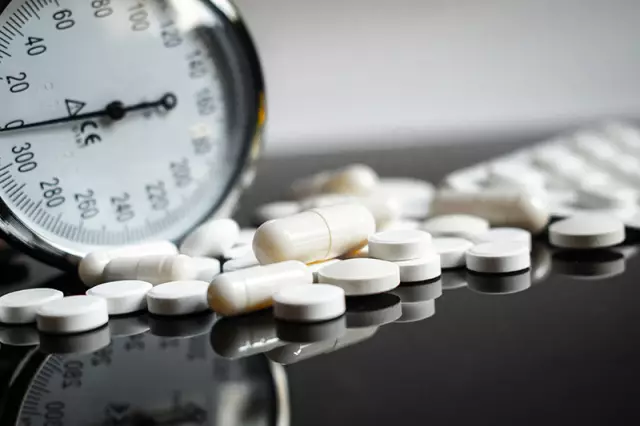- Author Rachel Wainwright [email protected].
- Public 2023-12-15 07:39.
- Last modified 2025-11-02 20:14.
Perchlozone
Perchlozon: instructions for use and reviews
- 1. Release form and composition
- 2. Pharmacological properties
- 3. Indications for use
- 4. Contraindications
- 5. Method of application and dosage
- 6. Side effects
- 7. Overdose
- 8. Special instructions
- 9. Application during pregnancy and lactation
- 10. Use in childhood
- 11. In case of impaired renal function
- 12. For violations of liver function
- 13. Use in the elderly
- 14. Drug interactions
- 15. Analogs
- 16. Terms and conditions of storage
- 17. Terms of dispensing from pharmacies
- 18. Reviews
- 19. Price in pharmacies
Latin name: Perhloson
ATX code: J04AK
Active ingredient: thioureidoiminomethylpyridinium perchlorate (Thioureidoiminomethylpyridinium perchlorate)
Manufacturer: Pharmasintez JSC (Russia)
Description and photo update: 2019-18-11

Perchlozone is an anti-tuberculosis agent.
Release form and composition
The drug is produced in the form of film-coated tablets: biconvex, round (200 mg) or oval (400 mg) shapes, from dark yellow to yellow, on one side with engraving PHZ; in cross section - from pale yellow to yellow with a faint green tint (10 pcs. in a blister made of aluminum foil and polyvinyl chloride film, in a cardboard box 5 or 10 blisters; 50 or 100 pcs. in a polymer can with a pull-on lid with first opening control; in a cardboard box 1 can and instructions for the use of Perchlozon; packs are placed in a group package).
1 tablet contains:
- active substance: thioureidoiminomethylpyridinium perchlorate (perchlozone) - 200 or 400 mg;
- additional components: crospovidone, povidone, microcrystalline cellulose, colloidal silicon dioxide, magnesium stearate;
- film shell: hypromellose E15, iron dye yellow oxide, hypromellose E5, macrogol 6000, titanium dioxide, talc, propylene glycol.
Pharmacological properties
Pharmacodynamics
Perchlozone is an anti-tuberculosis drug. The mechanism of action of the drug has not been finally clarified, the study continues.
The drug is active against Mycobacterium tuberculosis and Mycobacterium bovis. Demonstrates a pronounced inhibitory effect on the viability of mycobacterium tuberculosis, including those resistant to other anti-tuberculosis drugs. Perchlozone, being a low-toxic substance, does not lead to significant structural and functional disorders of vital organs and systems and does not irritate the mucous membranes of the gastrointestinal tract (GIT).
Pharmacokinetics
After oral administration, the drug is rapidly absorbed in the gastrointestinal tract. The period required to reach the maximum concentration (C max) of the active substance is 1.5-3 hours. With a single oral administration of the drug in doses of 400, 800, 1200 and 1600 mg, its C max is 2.61 ± 0.34; 5.07 ± 0.69; 5.42 ± 0.65 or 8.17 ± 1.91 μg / ml, respectively.
The half-life (T 1/2) can vary from 12 to 27 hours. The time to establish a steady-state concentration (C ss) of the drug in the blood with prolonged use is 14 days.
During the course of administration of the drug at a frequency of taking 1 time per day, the content of the active substance in the blood, measured 15 minutes before taking the next dose, is 23.4 μg per 1 ml of blood plasma. The pathways of biotransformation of the substance have not been determined; they are currently being studied.
Indications for use
Perchlozone is recommended for the treatment of pulmonary tuberculosis, including multidrug-resistant Mycobacterium tuberculosis, as part of a combination treatment.
Contraindications
Absolute:
- impaired liver and / or kidney function;
- age up to 18 years;
- pregnancy and lactation;
- hypersensitivity to any component of the drug.
The drug should be used with caution in elderly patients.
Perchlozon, instructions for use: method and dosage
Perchlozone tablets are taken orally, after meals. The frequency of admission is 1 time per day.
Recommended daily doses depending on body weight (based on 9.5-12.5 mg / kg / day):
- less than 50 kg: 400-600 mg;
- 50-80 kg: 800-1000 mg;
- more than 80 kg: not more than 1200 mg.
The duration of treatment is up to 3 months.
Side effects
Possible side effects of Perchlozone:
- nervous system and mental disorders: frequent - weakness, drowsiness or sleep disturbances, dizziness, headache, loss of consciousness, neuropsychic reactions (depression, aggression), peripheral neuropathy; infrequent - convulsive twitching, lethargy, deafness, confusion; isolated cases - generalized convulsive seizures;
- organ of vision: infrequent - photophobia;
- cardiovascular system: frequent - bradyarrhythmia; infrequent - a feeling of palpitations, deterioration of metabolic processes in the myocardium; extremely rare - a decrease in blood pressure (BP), tachycardia;
- digestive system: frequent - nausea, loose stools, vomiting, heaviness and pain in the epigastric region; infrequent - heartburn, bitterness in the mouth, hepatitis;
- respiratory system: extremely rare - bronchospasm;
- immune system: frequent - itching, rash; extremely rare - skin hyperemia, angioedema, toxic-allergic reactions;
- musculoskeletal system: frequent - arthralgia;
- changes in laboratory parameters: frequent - anemia, eosinophilia, hyperkalemia, hyperuricemia, an increase in the content of creatinine / bilirubin / blood glucose, an increase in the activity of hepatic transaminases, a decrease in the level of urine creatinine, proteinuria, erythrocyturia; infrequent - hypernatremia, thrombocytopenia, leukocyturia, increased concentration of lactate dehydrogenase (LDH), thyroid stimulating hormone (TSH) in the blood;
- other reactions: frequent - swelling of the face, eyelids, fever; infrequent - edema of the lower extremities; extremely rare - sensation of heat.
Overdose
Information about an acute overdose of Perchlozone in humans has not been recorded.
In case of a possible overdose, it is recommended to carry out general supportive treatment under the control of indicators of the main body functions. Prescribe gastric lavage, activated carbon intake. The specific antidote is currently unknown.
special instructions
If the development of allergic reactions is observed during therapy, it is required to stop taking the drug. In the event of the occurrence of other above-mentioned side effects of Perchlozone, it may be necessary to reduce the daily dose to 400 mg or to cancel the drug.
In case of fever, analgin (metamizole sodium) should not be used.
Influence on the ability to drive vehicles and complex mechanisms
The study of the impact of Perchlozone on the ability to drive vehicles and work with complex equipment has not been carried out. Side effects observed during treatment, such as dizziness, drowsiness, weakness, can cause a deterioration in the speed of reaction and concentration. As a result, it is not recommended to drive vehicles and work with complex and potentially dangerous equipment during therapy.
Application during pregnancy and lactation
Perchlozone therapy is contraindicated for pregnant and breastfeeding women.
Pediatric use
The drug is not used in pediatric practice.
With impaired renal function
In case of functional impairment of the kidneys, the use of Perchlozone is contraindicated, since the possibility of its use in this category of patients has not been studied.
For violations of liver function
In case of functional disorders of the liver, drug therapy is contraindicated, since the possibility of its use in this group of patients has not been studied.
Use in the elderly
Elderly people are advised to take Perchlozone with caution.
Drug interactions
Currently, the pharmacological interaction of thioureidoiminomethylpyridinium perchlorate with other drugs / agents is insufficiently studied.
In the case of the combined use of Perchlozone with amikacin, isoniazid, rifampicin, rifabutin or other anti-tuberculosis drugs, an increase in their activity against Mycobacterium tuberculosis is recorded, however, it is necessary to take into account the likelihood of mutual amplification of side effects.
Analogs
Perchlozone analogs are Metazid, Sirturo, Loxidon, Monopas, Sodium para-aminosalicylate, Petech, Pyrazinamide, Prothionamide, Terizidone, Ftivazid, etc.
Terms and conditions of storage
Store in a place out of the reach of children, protected from moisture and light, at a temperature not exceeding 25 ° C.
Shelf life is 2 years.
Terms of dispensing from pharmacies
Dispensed by prescription.
Reviews about Perchlozone
The pharmaceutical company that developed and manufactures the anti-tuberculosis drug emphasizes that the mechanism of its action has not been finally established, the study is still ongoing.
Perchlozone, according to reviews of some patients who used the drug, is an effective anti-tuberculosis agent, provided it is used as part of complex therapy. It allows to achieve clinical positive dynamics, improves the condition of patients even if they have multiple drug resistance, including to the most powerful anti-tuberculosis drugs.
At the same time, it is very often noted that thioureidoiminomethylpyridinium perchlorate is quite difficult from the point of view of tolerance, since it causes pronounced side reactions. It is highly toxic to the kidneys and liver, at the beginning of treatment, the body may become covered with a rash, there is constant nausea, severe vomiting, up to blood, terrible health, drowsiness and increased appetite. An episode of a ketoacidotic coma in a patient with diabetes mellitus taking Perchlozone is described. In some cases, when prescribing the drug, patients could not take therapy due to the development of severe undesirable effects.
Price for Perchlozone in pharmacies
The price of Perchlozon, film-coated tablets, for a package containing 100 pieces, may be: 200 mg - 22,700 rubles, 400 mg - 45,700 rubles.

Anna Kozlova Medical journalist About the author
Education: Rostov State Medical University, specialty "General Medicine".
Information about the drug is generalized, provided for informational purposes only and does not replace the official instructions. Self-medication is hazardous to health!






